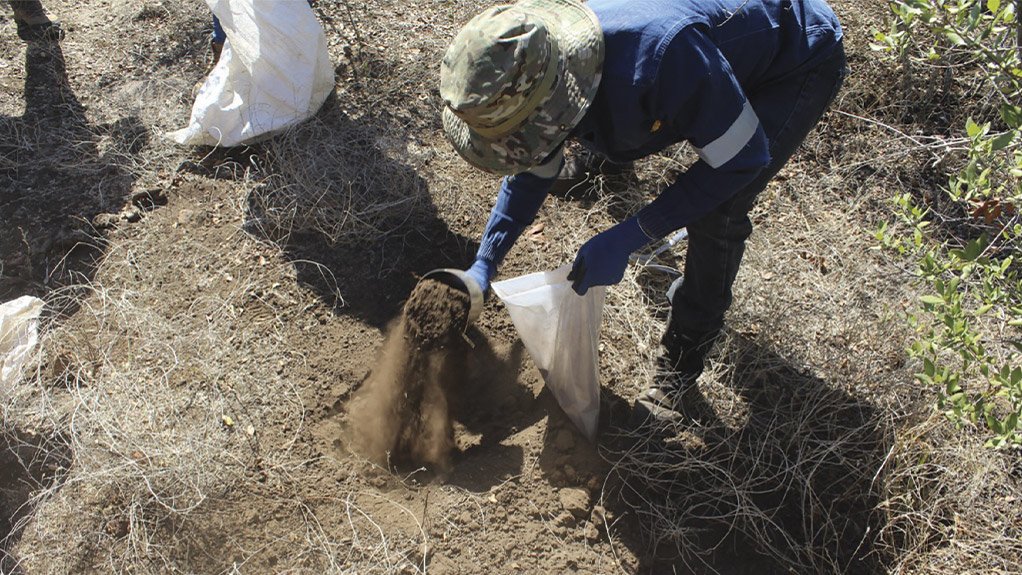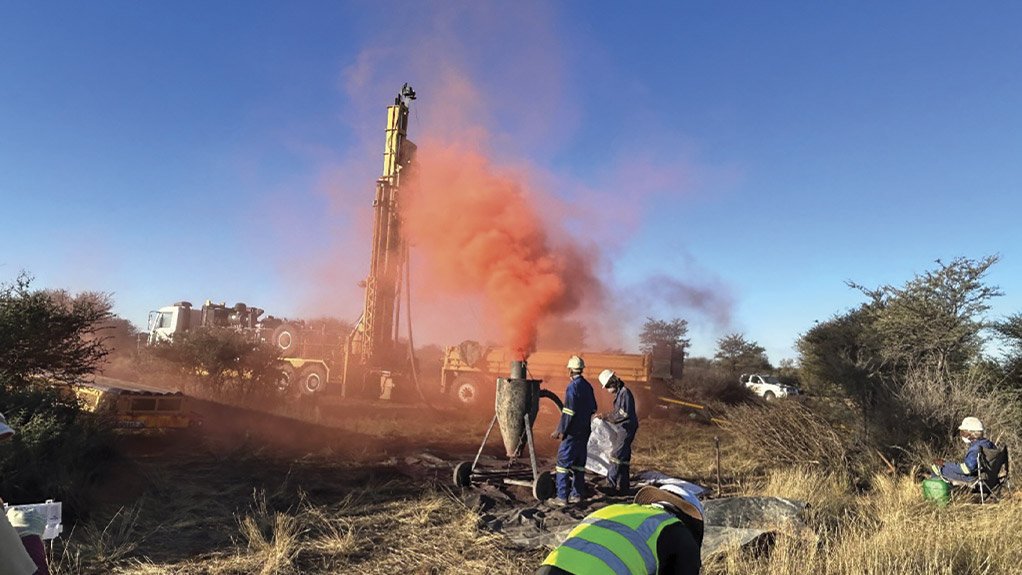The Council for Geoscience plays a critical role in promoting exploration in South Africa: the road to attaining 5% of the global exploration expenditure




CGS team of scientists, drillers and technical assistants preparing themselves to start drilling a reverse circulation borehole in the Giyani Greenstone Belt.
CGS technical assistant collecting a soil sample during a high-resolution soil sampling campaign in the Giyani Greenstone Belt.
Intersection of haematite ore during reverse circulation drilling in the Northern Cape Province.
Written by Asinne Tshibubudze and Mosa B. Mabuza (Council for Geoscience, Pretoria)
While there are numerous challenges facing the mining industry in South Africa, it is ultimately up to us, as South Africans, to prevent mining in this country from declining into a sunset industry. We alone hold the power to overcome environmental, social and financial challenges by implementing rational strategies and policies and, by so doing, to harness the benefit of mining for the good of all South Africans.
South Africa is endowed with one of the world’s pre-eminent pristine geological landscapes, covering time scales from the Precambrian to the Cenozoic. Within each geological timeframe, we have explored and exploited several mineral systems. For example, we have plumbed the depths of the Archaean and Paleoproterozoic terrains to explore for shear-hosted gold deposits in Archaean greenstone belts, sediment-hosted Cu-Pb-Zn-Ag, lithium, graphite, stratabound manganese and iron, placer gold and uranium and magmatic-hosted platinum group metals. In the past, we explored many of the terrains hosting these mineral systems, with major and reasonable discoveries alike having been made. That said, recently advanced and deployed exploration techniques in other parts of the world have prepared the way for us, as South Africans, to discover and develop a wealth of new mineral and petroleum deposits on our own doorstep.
For the longest time, South Africans have lived with the rhetoric held forth by critics who claim that the South African mining industry is dying because of a lack of new discoveries on a pipeline, while the old mines are rapidly approaching their end of life. The lack of new discoveries is ascribed to inadequate funding of local exploration with expenditure on this sector currently around 1% of the global available exploration expenditure. Because of a lack of funding, very few projects are being developed, with fewer still graduating to the mining stage.
The exploration industry globally is mainly anchored on junior explorers/miners. The absence of this sector in South Africa may well account for our stagnant mining industry. Junior explorers/miners are critical to ensuring that a range of well-diversified projects are gradually becoming available with a clear prospect of progressing to the mining stage. For mining projects to come to fruition, funding needs to be provisioned. The West African Craton, Guiana Shield and the Australian and Canadian Cratons are some global examples where junior explorers/miners are thriving and making discoveries supported by an enabling environment and investment from the Canadian and Australian markets.
It is important to note that the Council for Geoscience (CGS) has a rich history of generating and delineating targets based on regional mapping and geochemical soil data analysis spanning over 100 years. In this regard, the primary mandate of the CGS, as legislated by the Geoscience Act 100 of 1993, is to undertake both onshore and offshore geoscientific research. Moreover, through the Amendment of the principal Act, the mandate of the CGS has been extended to include promoting the search for, and the exploitation of, minerals in South Africa, as well as to undertake reconnaissance operations, prospecting and other related activities with a view to catalysing exploration activities in the country. Accordingly, the CGS has adopted a framework to provide prospecting research and related activities in the mineral sector to assist collaborators in respect of prospecting activities while, at the same time, creating income streams for the CGS to enable it to thrive as an organisation and to expand its activities.
The CGS has identified critical metallogenic areas marked as high-priority zones for key critical minerals such as copper, lithium, graphite, iron, manganese and rare earth elements (REEs). The organisation has deployed scientists in all nine provinces of South Africa. They are mapping and highlighting key occurrences within South African borders, including its offshore area, by undertaking detailed research coupled with drilling as part of the exploration programme.
The CGS exploration programme involves data acquisition using high-resolution ground mapping, geochemical sampling, hydrological mapping and geophysical surveys, including magnetics, magnetotellurics, induced polarisation and stratigraphic and mineral drilling. These methods have been tested in Limpopo–Giyani greenstone belt for gold exploration and in the Northern Cape province for copper, nickel and manganese exploration.
In the Giyani greenstone belt, these methods have been applied in conjunction with more than 300 historical boreholes distributed over the greenstone belt, resulting in the drilling of targets. Mineralised zones exhibiting a gold grade of >5g/t have been intersected at shallow depths of between 10 m and 20 m. CGS scientists have also delineated REE and phosphate targets in the Schiel Complex. In the Northern Cape province, a detailed pilot project undertaken as a joint venture with entrepreneurs is underway to test an area for manganese and iron ore in the vicinity of the Kalahari. This is proving to be a quick and focussed approach to de-risking virgin terrains and, consequently, increasing the confidence level and interest of investors in greenfield exploration of the pristine South African geological landscape.
The CGS will continue to test and de-risk additional targets, making the data available to the public as we continue to contribute and enable exploration in South Africa. The provision of 1:50 000-scale maps and historical data via our portal is improving the delineation of exploration targets and, in so doing, greatly assisting explorers. The use of the CGS data portal continues to enable and enhance agile exploration work.
Concerns regarding the cadastral system and government policies have been identified as contributing factors to the current stagnation of the exploration industry in South Africa. While one might argue that most of our problems in South Africa are self-inflicted, there are many African countries such as Burkina Faso, Mali and Niger who boast a flourishing exploration industry and who are frequently commissioning new mines. These achievements are attained despite unstable geopolitics and the absence of mining cadastres.
As South Africans involved in the mineral exploration industry, the CGS firmly believes that it is possible for South Africa to achieve a 5% share of the global exploration expenditure. To accomplish this goal, we need to work together, both as State institutions and private entities. Above all, we must not leave it up to either the government or the private sector alone to achieve the 5% target. Therefore, Government has initiated a process to ensure that our pristine geology is attractive to local and international investors alike. The CGS has a critical role to play in this regard.
Comments
Press Office
Announcements
What's On
Subscribe to improve your user experience...
Option 1 (equivalent of R125 a month):
Receive a weekly copy of Creamer Media's Engineering News & Mining Weekly magazine
(print copy for those in South Africa and e-magazine for those outside of South Africa)
Receive daily email newsletters
Access to full search results
Access archive of magazine back copies
Access to Projects in Progress
Access to ONE Research Report of your choice in PDF format
Option 2 (equivalent of R375 a month):
All benefits from Option 1
PLUS
Access to Creamer Media's Research Channel Africa for ALL Research Reports, in PDF format, on various industrial and mining sectors
including Electricity; Water; Energy Transition; Hydrogen; Roads, Rail and Ports; Coal; Gold; Platinum; Battery Metals; etc.
Already a subscriber?
Forgotten your password?
Receive weekly copy of Creamer Media's Engineering News & Mining Weekly magazine (print copy for those in South Africa and e-magazine for those outside of South Africa)
➕
Recieve daily email newsletters
➕
Access to full search results
➕
Access archive of magazine back copies
➕
Access to Projects in Progress
➕
Access to ONE Research Report of your choice in PDF format
RESEARCH CHANNEL AFRICA
R4500 (equivalent of R375 a month)
SUBSCRIBEAll benefits from Option 1
➕
Access to Creamer Media's Research Channel Africa for ALL Research Reports on various industrial and mining sectors, in PDF format, including on:
Electricity
➕
Water
➕
Energy Transition
➕
Hydrogen
➕
Roads, Rail and Ports
➕
Coal
➕
Gold
➕
Platinum
➕
Battery Metals
➕
etc.
Receive all benefits from Option 1 or Option 2 delivered to numerous people at your company
➕
Multiple User names and Passwords for simultaneous log-ins
➕
Intranet integration access to all in your organisation



















